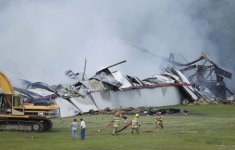'Some media reports said the B.E.M. facility did not have fire sprinklers, but Wade noted that sprinklers would not necessarily have been able to stop the fire.
“You can’t put out a fireworks fire, because it contains its own oxygen,” he explained. “Once it starts, move back and let it go.”
Fireworks consist of two major parts — a fuel source, like black powder, and an oxidizer, like potassium or ammonium nitrate. The chemical reaction that produces colour and smoke can’t happen without an abundance of oxygen, which the oxidizer provides.
That combination makes fireworks fires very difficult to extinguish, Wade said.'
Explosion could have been worse: expert
The explosion that killed two workers and rocked Coteau-du-Lac and its surrounding area Thursday morning could have been far worse if it were not for strict safety regulations, a fireworks expert says.
“If something goes wrong, it’s not like you’re dealing with pantyhose. Something bad happens,” said Fred Wade, president of the Canadian Pyrotechnic Council, an industry association for fireworks companies.
Despite the unfortunate events, “everything worked here in this case,” Wade said. “Tremendous explosion, huge amount of energy released, but it was confined to the facility itself.”
Because the stakes are so high, the industry operates under strict federal regulations, Wade explained.
Facilities like the B.E.M. plant that exploded in Coteau-du-Lac, west of Montreal, are inspected at least once a year, and must renew their licences annually.
Under federal law, the maximum amount of explosive material a factory may store depends on how close it is to populated areas.
In 2000, a devastating explosion at a fireworks facility in Enschede, Holland, killed 23 people and injured almost 1,000.
The blast “flattened the entire downtown core of Enschede,” Wade said. A similar explosion in Denmark in 2004 killed one, injured dozens and destroyed almost 200 homes.
A 2009 explosion at a fireworks factory in the Philippines killed eight and injured 40, while another in the same country in 2013 killed two people.
“That will not happen in Canada, because of the regulations we work under.” Wade said.
“You move to other countries and you see some scary things. Even our cousins to the south, the Americans — that’s the Wild West, compared to Canada when it comes to fireworks,” he said.
In the United States, fireworks are regulated by individual states. Wade noted that, unlike in Canada, some states allow companies to transport live fireworks while they are connected to igniters, and thus are far more likely to go off unexpectedly.
Other states, like Texas, do not have fire codes at all, he said. That lack of regulatory oversight has been blamed by some for the catastrophic explosion at a fertilizer plant in West, Texas, that killed more than a dozen people and obliterated most of the small town.
“It just blows your mind,” Wade said.
Some media reports said the B.E.M. facility did not have fire sprinklers, but Wade noted that sprinklers would not necessarily have been able to stop the fire.
“You can’t put out a fireworks fire, because it contains its own oxygen,” he explained. “Once it starts, move back and let it go.”
Fireworks consist of two major parts — a fuel source, like black powder, and an oxidizer, like potassium or ammonium nitrate. The chemical reaction that produces colour and smoke can’t happen without an abundance of oxygen, which the oxidizer provides.
That combination makes fireworks fires very difficult to extinguish, Wade said.
“You probably wouldn’t even find fire extinguishers in that facility, because if there is any accidental ignition, you’ve got seconds to get out,” he added.
When trucks transport fireworks to a show, he said, they carry a fire extinguisher, but only to deal with engine fires. If the cargo looks like it might ignite, drivers are trained not to try to put out the fire.
“Then we switch to damage control — keeping spectators back at a safe distance, securing the site, so that if the fire does reach the load it’ll just look pretty, like the moose incident with the courier truck.”
In early June a Purolator truck loaded with fireworks collided with a moose in rural Ontario. Fuel in the truck caught fire, igniting the cargo and lighting up the night for several hours as fireworks cooked off in the blaze.
The cause of the Coteau-du-Lac blast is still unknown, but Wade speculated that it may have been caused by a malfunctioning electrical igniter.
The igniters are used to trigger fireworks. By law they cannot be connected to fireworks until at the site of a fireworks show.
“If there’s an accidental ignition, the firework is going to function, I may wet my pants, but no one is going to get killed,” Wade said.
The B.E.M. facility was one of the largest in the country, Wade said. “They’re a longtime, large member of the fireworks community in Canada. A real pillar of the fireworks industry.”
B.E.M. Fireworks was last chosen to represent Canada in the 2012 International des Feux Loto-Québec, the prestigious fireworks competition that has been wowing spectators at Montreal’s La Ronde amusement park for decades.
The company has been front and centre at the competition four times. Their first show was in 2000; in their second outing in 2005, B.E.M. won third place – a bronze Jupiter prize. They again staged the show on behalf of Canada in 2011.
In addition to the factory that blew up Thursday, B.E.M. also operates a retail operation familiar to travellers on Highway 20.
Like many factories across Canada, B.E.M. would have been busy, preparing for the St. Jean Baptiste and Canada Day weekends.
Anne Sutherland of The Gazette contributed to this report
[email protected]
Twitter: sparksriley
© Copyright (c) The Montreal Gazette
Bron:
http://www.edmontonjournal.com/trav...ompany+international+award/8553233/story.html

